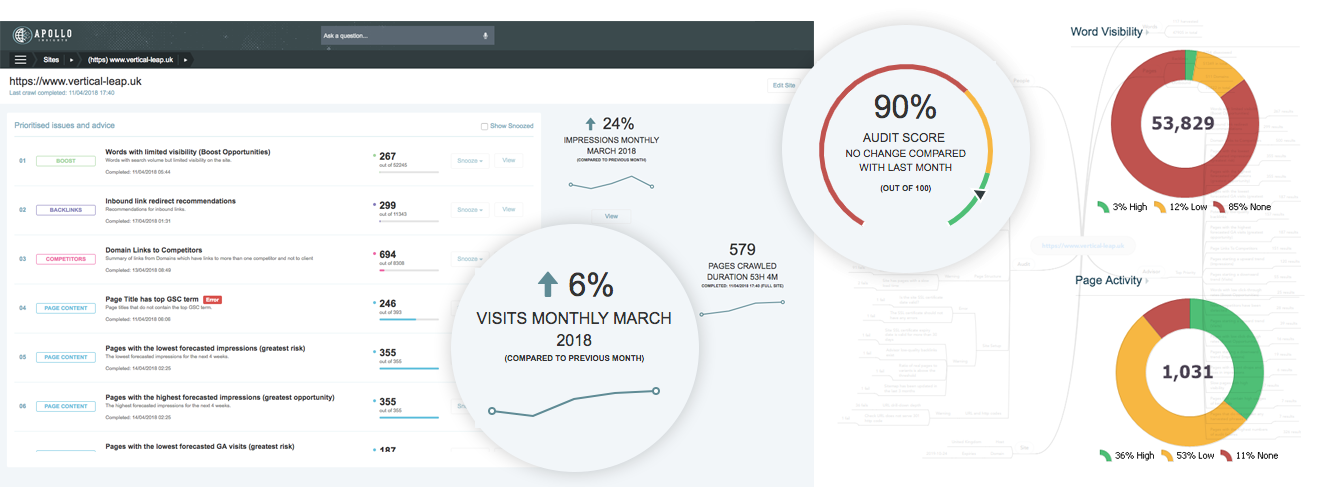For digital marketing and website teams, the inability to take data-driven marketing action soon enough is a frequent barrier toward online success.
Today, we face a variety of challenges, such as:
- An overwhelming volume of data.
- A tendency to over analyze data.
- Stagnating websites.
- Content creation that fails to deliver any results.
Businesses should maximize the untapped potential within their data on a monthly basis.
To achieve this, prioritizing data and building a culture of action-taking and experimentation is essential.
Here are some of my favorite data-driven actions and company culture changes that support search marketing success.
1. Have Processes in Place for Fast Recombining of Data Sets
As marketing experts, people want to spend time on the creative aspects of search marketing delivery.
Yet, for many, the initial roadblock preventing them from taking action stems from all of the dispersed data points they are expected to digest.
A typical marketing expert or manager is exposed to 20 or more different data tools and analytics packages.
Enabling easy distillation of all this data and bringing all the related data into a reduced set of several reference points will help ensure expertise time is being used on expert tasks.
At this stage, it is about considering all the data sources that matter most to the business.
You also need to make impactful decisions on:
- How to pull out (via APIs, for example) all of the key data into deeper data platforms.
- More data friendly visualization packages (such as PowerBI).
Both of which can expedite the journey from data, to information and insights.
Recent examples of companies helping facilitate this include the latest Google Search Console aggregation of search properties to track everything under a single domain view.
The gains made from this process update include:
- Faster action taking.
- Reduced time wastage on basic data collection and refinement work.
- Increased time to vary actions and experiment.
- Improved staff sentiment as they are doing less manual and laborious tasks.
- More frequent website updates.
- Increased content and page refinements generating greater gains.
Deep data platforms have come to the fore over the past five-plus years predominantly due to this volume of data handling, combined with the need to make faster, and more meaningful business decisions repeatedly out of the ever-changing data sets.
An example of this in action can be seen with Apollo (the deep data marketing system I work with, created by the company I work for).

Using this type of deep data marketing platform for quicker website and marketing action-taking (above the fundamental data gathering, recombining, and integrity work) has its advantages. Here are just a few:
- Prioritized insights
- Predictive analytics
- Diagnostic analytics
- Natural language processing
- Forecasting
- Interactive dashboards and reporting
- Filterable grids
2. Timebox Actions into Shorter 15-30 Minute Chunks
Marketing experts often have the dreaded mentality of needing to follow the rabbit hole.
This means that once experts begin looking into the data with a goal in mind, they quickly become waylaid. They follow the data path into new and interesting areas, yet ultimately fail to take any impactful form of direct action from it.
Evidence of this in action include:
- Lack of output or outcomes from time invested.
- Limited results derived.
- Failure to deliver actions to deadlines.
To solve this, you need to be stricter in timeboxing actions and then break down projects and larger implementation items into shorter delivery timeframes.
A huge amount can be achieved in a 15-30 minute timeframe when a skilled marketing expert is focused on the task in hand and has a clearly defined purpose.
A relevant time to get immersed in the data is during start-of-month ideation sessions where you establish:
- The goals, objectives, and key performance areas for the month (and likely the wider quarter).
- The agreed actions.
- The people to implement them (with the deadline).
But there is a need to balance this ideation approach and protect dedicated times when taking action must be prioritized over everything else.
Otherwise, you have a huge backlog of missed opportunity and overlooked actions which were time-sensitive and never delivered on.
Building into reporting a specific section for next actions and what actions were completed in the previous month will help delivery teams think about:
- What was achieved.
- What the next data-led actions will be using the latest data sets.
Simple approach revisions like the above will help build consistency of approach spanning teams and staff. This ensures that there is a mindset that things are happening and your data is leveraged.
Examples of implementing 15-30 minute website marketing actions from the latest data sets include:
- Updating metadata to reflect the latest search trends, user behavior, and highest opportunity Google Search Console terms.
- Revising content to include new questions and answers that people have used to discover it as well as to help target new search terms from the terminology used by the audience.
- Re-pitching content created to focus on inclusion in Google Rich Results such as Google Answers, using the data to inform updates made.
- Updating the content using heatmaps and screen recordings, basing updates on data generated so that you can position calls to action, short forms, and other engagement items on the elements of the screen which users are attracted to the most.
- Seeding core terms into the content based on boosting the ranking terms which the page is appearing for, increasing the topical relevancy and direct term association with the queries driving the highest impressions and traffic.
You can even complete a technical SEO audit in 15 minutes when you have everything in place and take a structured approach to complete it.
3. Use Agile Backlogs for Next Data Actions & Insights
There will always be a wealth of ideas and opportunities for new actions to take when you start to analyze data and analytics packages. It’s important that this unrealized potential value does not get lost because of current time availability.
The main characteristics of an effective backlog include:
- Clearly prioritized actions.
- The inclusion of expected time to complete.
- Peoples names assigned to tasks.
- Tracking of completed actions for easy repeat use and action ideation.
- Objective / goal from the action.
- Defined actions which can easily be completed without discussion.
- Wider team access to the backlog.
- Easy feedback loops (the ability for anyone to comment, share results, and discuss pertinent points).
A backlog should be seen as an organic entity that collates information and insights through dedicated action allocation.
Anyone should be able to proactively take on a task unassigned, assigned to them, or assigned to somebody else, assuming they have the capability to do so.
This proactive approach to taking action and the inclusion of everyone for making changes support a richer company environment of getting things done and delivering results.
In Conclusion
For website and marketing teams to achieve results anywhere near the potential that exists within the data, they need to be able to take action sooner and more often.
For this to happen it is necessary to:
- Effectively recombine data sets.
- Timebox actions into shorter more purposeful timeframes.
- Use agile and effective backlogs to capture and implement the new opportunity.
There are many ways in which you can positively impact action-taking from website data. Hopefully this post helps facilitate that sooner.
More Resources:
- Data Visualization: What It Is, Why It’s Important & How to Use It for SEO
- Content Marketing KPIs: Your Guide to Picking the Right KPIs for Content
- What Digital Marketers Need to Know About Cookies & Tracking
Image Credits
All screenshots taken by author, March 2019




